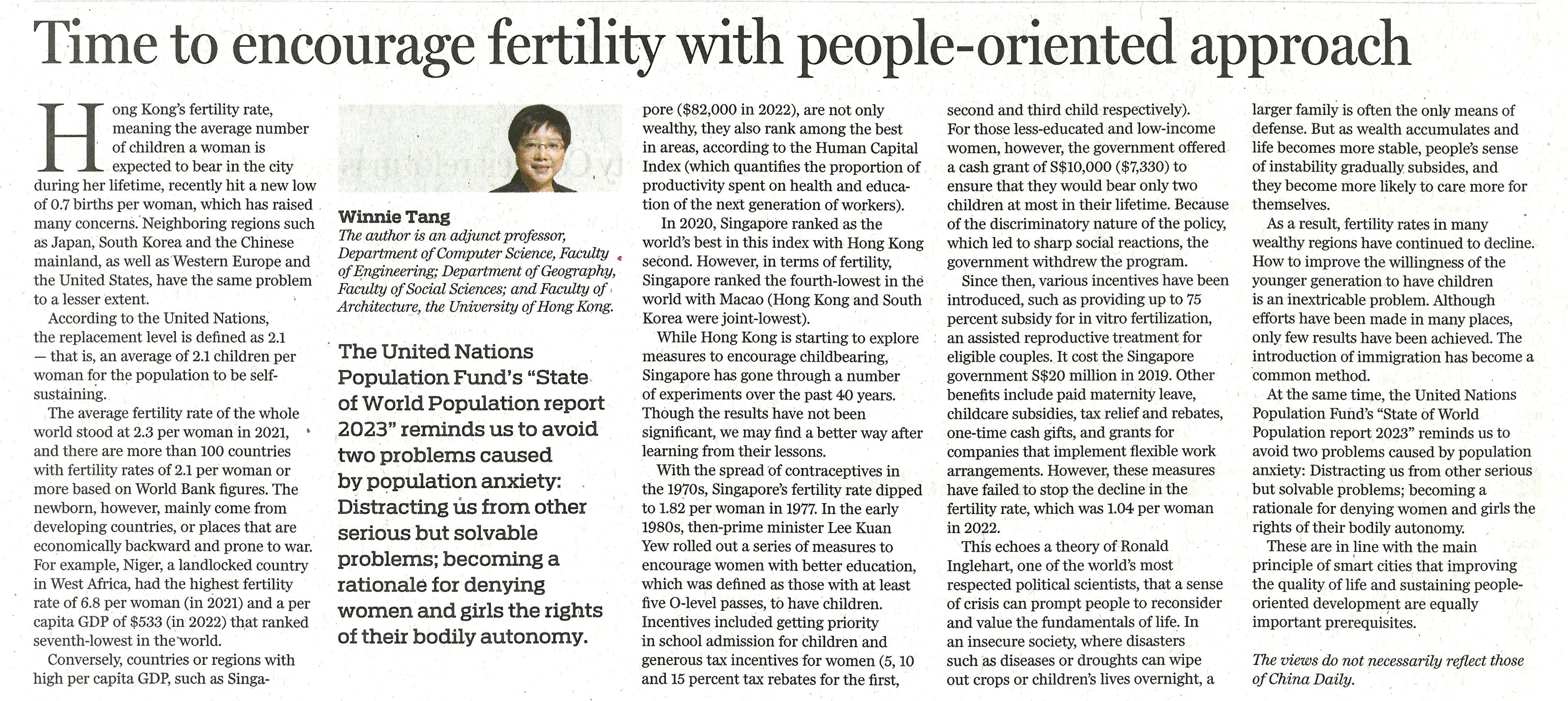網上版請按此

Time to encourage fertility with people-oriented approach
Hong Kong's fertility rate, meaning the average number of children a woman is expected to bear in the city during her lifetime, recently hit a new low of 0.7 births per woman, which has raised many concerns. Neighboring regions such as Japan, South Korea and the Chinese mainland, as well as Western Europe and the United States, have the same problem to a lesser extent.
According to the United Nations, the replacement level is defined as 2.1 — that is, an average of 2.1 children per woman for the population to be self-sustaining.
The average fertility rate of the whole world stood at 2.3 per woman in 2021, and there are more than 100 countries with fertility rates of 2.1 per woman or more based on World Bank figures. The newborn, however, mainly come from developing countries, or places that are economically backward and prone to war. For example, Niger, a landlocked country in West Africa, had the highest fertility rate of 6.8 per woman(in 2021) and a per capita GDP of$533(in 2022) that ranked seventh-lowest in the world.
Conversely, countries or regions with high per capita GDP, such as Singapore ($82,000 in 2022), are not only wealthy, they also rank among the best in areas, according to the Human Capital Index(which quantifies the proportion of productivity spent on health and education of the next generation of workers).
In 2020, Singapore ranked as the world's best in this index with Hong Kong second. However, in terms of fertility, Singapore ranked the fourth-lowest in the world with Macao (Hong Kong and South Korea were joint-lowest).
While Hong Kong is starting to explore measures to encourage childbearing, Singapore has gone through a number of experiments over the past 40 years. Though the results have not been significant, we may find a better way after learning from their lessons.
With the spread of contraceptives in the 1970s, Singapore's fertility rate dipped to 1.82 per woman in 1977. In the early 1980s, then-prime minister Lee Kuan Yew rolled out a series of measures to encourage women with better education, which was defined as those with at least five O-level passes, to have children. Incentives included getting priority in school admission for children and generous tax incentives for women (5, 10 and 15 percent tax rebates for the first, second and third child respectively). For those less-educated and low-income women, however, the government offered a cash grant of S$10,000 ($7,330) to ensure that they would bear only two children at most in their lifetime. Because of the discriminatory nature of the policy, which led to sharp social reactions, the government withdrew the program.
Since then, various incentives have been introduced, such as providing up to 75 percent subsidy for in vitro fertilization, an assisted reproductive treatment for eligible couples. It cost the Singapore government S$20 million in 2019.Other benefit sinclude paid maternity leave, child-care subsidies, tax relief and rebates, one-time cash gifts, and grants for companies that implement flexible work arrangements. However, these measures have failed to stop the decline in the fertility rate, which was 1.04 per woman in 2022.
This echoes a theoryof Ronald Inglehart, one of the world's most respected political scientists, that a sense of crisis can prompt people to reconsider and value the fundamentals of life. In an insecure society, where disasters such as diseases or droughts can wipe out crops or children's lives overnight, a larger family is often the only means of defense. But as wealth accumulates and life becomes more stable, people's sense of instability gradually subsides, and they become more likely to care more for themselves.
As a result, fertility rates in many wealthy regions have continued to decline. How to improve the willingness of the younger generation to have children is an inextricable problem. Although efforts have been made in many places, only few results have been achieved. The introduction of immigration has become a common method.
At the same time, the United Nations Population Fund's "State of World Population report 2023" reminds us to avoid two problems caused by population anxiety: Distracting us from other serious but solvable problems; becoming a rationale for denying women and girls the rights of their bodily autonomy.
These are in line with the main principle of smart cities that improving the quality of life and sustaining people-oriented development are equally important prerequisites.
Dr. Winnie Tang
Adjunct Professor, Department of Computer Science, Faculty of Engineering; Department of Geography, Faculty of Social Sciences; and Faculty of Architecture, The University of Hong Kong